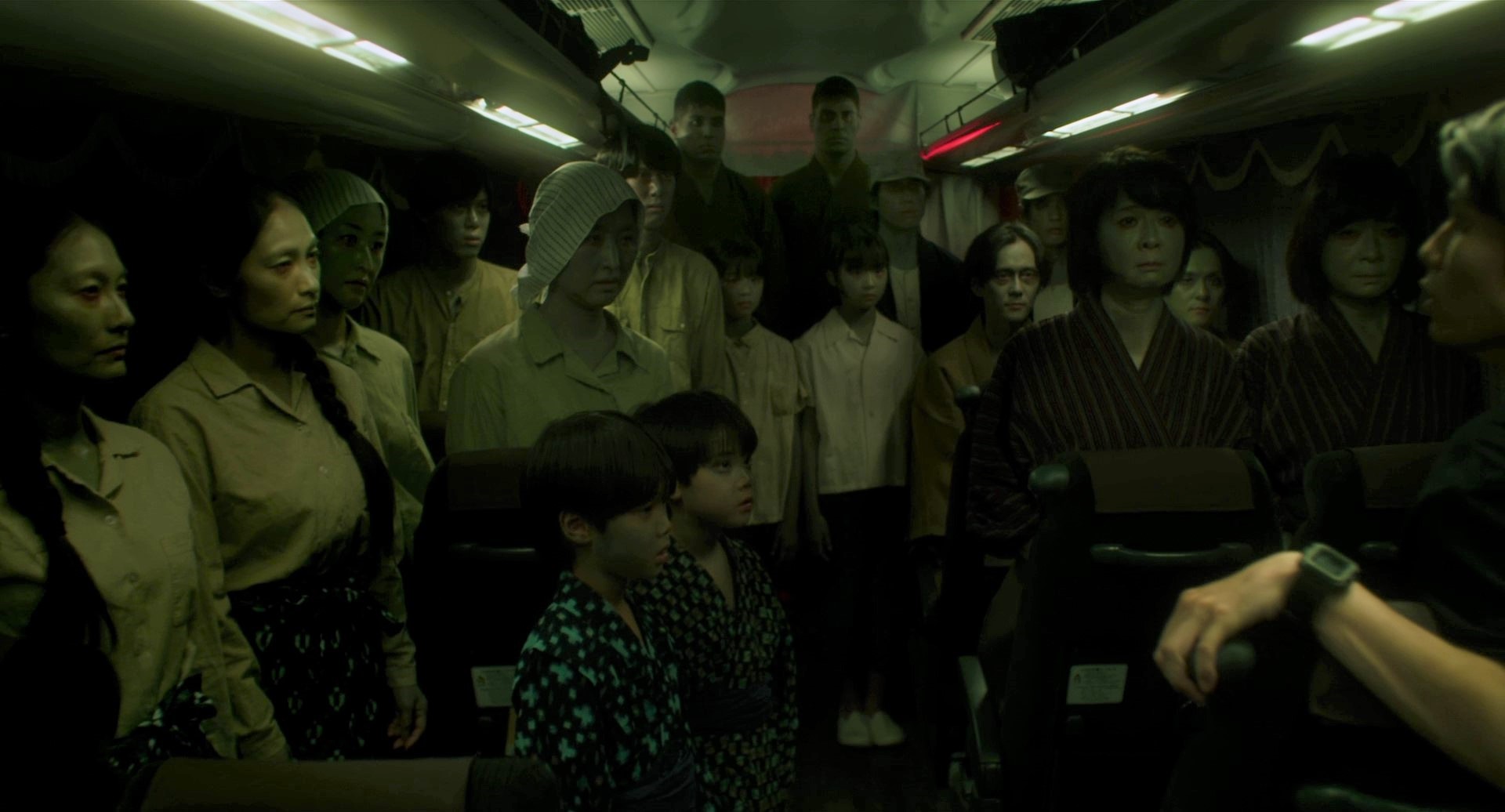
Veteran fans of Japanese horror are familiar with the name Takashi Shimizu, there’s no doubt about it. Having gained attention from horror fans all around the world with his Ju-On franchise, Shimizu-san has been a continuous contributor to the genre with varying reception from his audience. Admittedly, I haven’t been a good audience for some of his most recent efforts, but I’m always eager to check out his latest projects regardless. And although I wasn’t too keen on his Howling Village film, which was due to my personal expectations and not the quality of the film itself, I did end up thoroughly enjoying the second film in the series, Suicide Forest Village. Because of this, I was significantly curious to see what was in store for us in the final film of the trilogy, Ox-Head Village.
Like the two films that came before it, Ox-Head Village is inspired by an allegedly haunted area, this time being the much lesser known spot in Uozu called the Tsubono Hotel. If you’re unfamiliar with the story behind this locale (like I was before looking into it) it was recognized as a paranormal hot spot for years and garnered massive attention when two high school girls went to explore the area in 1996 but never returned home. Their bodies were found in a car at the bottom of a nearby port twenty-five years later, and in 2014, three anonymous witnesses told the local police that they had seen a car with those two girls inside it roll backwards into the bay at Fushiki Port. Rather than putting the internet rumors to rest, these testimonies and the bizarre time gap between each new development only intensified everyone’s curiosities.

Unsurprisingly, Shimizu-san took immense creative liberties with his story, not unlike how he did with the first two entries. His tale begins with three high school students documenting their exploration of an abandoned hotel via an online live stream. Two of the girls place a cow mask on the third and coerce her into entering an elevator and lock her in as a sort of prank. Things quickly go downhill when the third girl is attacked by a malevolent force and inexplicably disappears. This live stream not only goes viral but becomes of special interest to Kanon, a high school senior who bears a striking resemblance to the girl under the cow mask in the video. Kanon, along with her schoolmate Ren, who is responsible for showing her the video in the first place, begins to investigate the look-alike’s whereabouts and uncover the mystery behind the area’s tragic past.
The main hype surrounding this film for Japanese audiences, in particular, was the casting of Kōki, the daughter of beloved icon Takuya Kimura. Ox-Head Village not only marks her acting debut, it also marks her first lead role. Japanese moviegoers were ardently anticipating her presence on the big screen and rooted for her as she followed the footsteps of her father. Though not a terribly demanding role, Kōki gives a solid performance, effortlessly matching the caliber of the previous leading ladies in the series. She seemed to really be in her element and was proficient enough to carry most of the film on her shoulders. She was technically tasked with playing two roles here, with the cow-masked school girl being the second, but the mystery behind this secondary character won’t come as much of a shock to most viewers, and I would even go as far as saying that the eventual reveal was made blatantly obvious in the trailer alone.

Even if this revelation doesn’t surprise you (it’s revealed fairly early on so I’m unsure if Shimizu-san meant for it to be obvious), the real crux of the story becomes focused on the dark past surrounding the village that existed before the hotel was built. Fans of Tecmo’s Fatal Frame II: Crimson Butterfly will instantly recognize the themes and imagery on display, which I believe will work to the film’s benefit rather than inspire vitriol from the fan base. That’s not to say that some viewers won’t write off the film as derivative, which is unfortunate considering it has plenty of entertainment value. The scares here range from pleasantly ambitious to relatively goofy; the image of someone wearing a dead cow head may sound unsettling on paper, but often comes across as a bit zany. To counter these offbeat moments, Shimizu-san has sprinkled a number of creative set pieces throughout, one of which involves a neat camera trick combined with minimal special effects to illustrate the demise of a falling specter.
The overall mood of the film is very akin to both Howling Village and Suicide Forest Village, so fans who have been following the series don’t have to worry about any unexpected tonal shifts, despite there being hints of that from the trailer. Aside from the Easter Eggs confirming a shared universe (there’s one here similar to the one in the second film), the utilization of ancient rituals gone wrong unifies this trinity of films and helps them feel more grounded when juxtaposed with some of the more fantastical aspects. This is also the main reason why I believe that the subject matter will sit well with fans of the Fatal Frame video game series; the motif of failed rituals is vital to that franchise and its effectiveness has yet to dwindle within the fan base. Granted, it’s been eight years since we last saw a new entry in the series, but the passion and desire for more sequels is unwavering even till this day.

Out of the three films, Ox-Head Village is perhaps the most conventional compared to the first two. I wouldn’t say that it’s particularly scary, but there are plenty of expertly crafted horror sequences that will please fans of the supernatural Japanese films that were popular during the early 2000s. One of the many things I appreciate about Shimizu-san is his commitment to this genre; even though he’s dipped his toes into other genres numerous times over the years, he always finds himself coming back to modern-day ghost stories that somehow correlate with old urban legends. This is a sub-genre that I greatly adore, and it’s not as common as it once was. Perhaps the best way to fully enjoy this particular trilogy is by approaching them as dark fairy tales as opposed to linear portrayals of the alleged real-life haunted locations they’re based on. My opinions of Howling Village remain the same, but I can better appreciate the overall trilogy when looking at it from this perspective.
Ox-Head Village has yet to receive an official release outside of Japan, but its predecessors are both currently available to stream in the west. I believe it is only a matter of time before the final film follows suit, and I am cautiously hoping that all three films will eventually be released in a physical box set; perhaps one that is designed to look like the cursed box from the second film!
More Film Reviews
Alone With You (2021) Film Review – A Metaphysical Nightmare
There are many different types of fears that can fester in the mind, everyone on some level knows what their greatest nightmare is – experiencing such emotions is an unavoidable…
Haunted Ulster Live (2023) Film Review – Tune In for Horrors Near You [Unnamed Footage Festival 7]
In the tradition of pseudo-local-TV broadcasts like Ghostwatch and WNUF Halloween Special, homegrown horror heads to N.Ireland in Dominic O’Neill’s Haunted Ulster Live. Set in 1998, TV newscaster Gerry Burns…
The Dark and The Wicked (2020) Film Review: Unrelenting Evil, Uncompromising Terror
Off of the back of our best of 2020 list came a slew of recommendations through both our facebook pages, The Yurei and The Banshee. Out of multiple titles recommended,…
No Escape (1994) Film Review – Big Budget Blockbuster with a B-Movie heart
No Escape is a 1994 American action sci-fi, based on the novel The Penal Colony written by Richard Herley. The novel was adapted to the screen by Michael Gaylin and…
We’re Not Here to Fuck Spiders (2020) Film Review – Found Footage from Down Under
We’re Not Here to Fuck Spiders is a 2020 Australian found footage horror movie written and directed by Josh Reed, who is primarily recognized for his directing work on television…
The Loneliest Boy in the World (2022) – Just Dig Up A Best Friend If You Need One
After the tragic loss of his mother, Oliver is threatened with state custody unless he can find a new family. And so Oliver does just that… by digging one up…

Your typical ghoul next door; film enthusiast, horror fanatic, J-horror nerd, aspiring horror host, and all around geek. Will likely be found cuddling with their cat and reading an old smelly book, or stuffing their face with popcorn at the cinema!

![Haunted Ulster Live (2023) Film Review – Tune In for Horrors Near You [Unnamed Footage Festival 7]](https://www.grimoireofhorror.com/wp-content/uploads/2024/03/Haunted-Ulster-Live-Title-Card-365x180.jpg)



